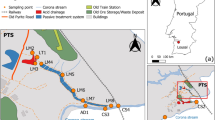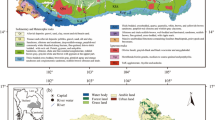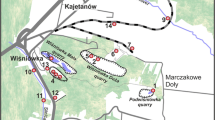Abstract
Rare earth elements (REEs) are a natural resource of vital economic interest. While REE mining and processing are known for severe environmental issues, REEs are also by-products of other mining processes (e.g. uranium). Here, we provide an in-depth assessment of REE distribution across a lake system impacted by adjacent uranium mining over a long period (Bow Lake, Ontario, Canada). We observed a robust REE-U correlation with a consistent La/U ratio of 2.0 ± 0.2 and La concentrations up to 2200 µg g−1. Selective extraction results demonstrated that 80–94% of REEs were acid extractible, while 3–8% of REEs were extracted by an alkaline solution (i.e. bound to natural organic matter). Analysis of specific REE patterns, together with a strong REE-P correlation, suggest that (co)precipitation with P mineral would be an important mechanism sequestrating REEs into Bow Lake sediments. Moreover, we identified three sources of particles delivering REEs into the lake with unique REE patterns: mine tailings, U ores and Precambrian bedrock. Negative Sm anomalies were detected in three soil samples and associated with the Precambrian bedrock. We also detected positive Gd and La anomalies in the sediments. Lanthanum anomalies were strongly correlated with U authigenic accumulation and thus associated with microbial processes requiring La, such as methanotrophy. This research demonstrates that lake sediments adjacent to U mining could represent ecological risks given that La and other REE concentrations largely exceed the maximum permissible concentrations. Water and sediment quality criteria are therefore required as both primary REE mining and extraction of REEs as by-products from legacy metallurgical tailings are increasing.







Similar content being viewed by others
Availability of Data and Material
The data are available as Supplementary Data file.
Code Availability
Not applicable.
References
Auer G, Reuter M, Hauzenberger CA, Piller WE (2017) The impact of transport processes on rare earth element patterns in marine authigenic and biogenic phosphates. Geochim Cosmochim Acta 203:140–156. https://doi.org/10.1016/j.gca.2017.01.001
Balboni E, Simonetti A, Spano T et al (2017) Rare-earth element fractionation in uranium ore and its U(VI) alteration minerals. Appl Geochem 87:84–92. https://doi.org/10.1016/j.apgeochem.2017.10.007
Bayon G, Toucanne S, Skonieczny C et al (2015) Rare earth elements and neodymium isotopes in world river sediments revisited. Geochim Cosmochim Acta 170:17–38. https://doi.org/10.1016/j.gca.2015.08.001
Binnemans K, Jones PT, Blanpain B et al (2013) Recycling of rare earths: a critical review. J Clean Prod 51:1–22. https://doi.org/10.1016/j.jclepro.2012.12.037
Burns PC, Finch R (1999) Uranium: mineralogy, geochemistry and the environment. Reviews in Mineralogy, Washington, DC
Byrne RH, Kim KH (1990) Rare earth element scavenging in seawater. Geochim Cosmochim Acta 54:2645–2656. https://doi.org/10.1016/0016-7037(90)90002-3
Chakraborty P, Raghunadh Babu PV, Sarma VV (2011) A multi-method approach for the study of lanthanum speciation in coastal and estuarine sediments. J Geochem Explor 110:225–231. https://doi.org/10.1016/j.gexplo.2011.05.013
Cleveland CC, Liptzin D (2007) C:N: P stoichiometry in soil: is there a “Redfield ratio” for the microbial biomass? Biogeochemistry 85:235–252. https://doi.org/10.1007/s10533-007-9132-0
Cobelo-García A, Filella M, Croot P et al (2015) COST action TD1407: network on technology-critical elements (NOTICE)—from environmental processes to human health threats. Environ Sci Pollut Res 22:15188–15194. https://doi.org/10.1007/s11356-015-5221-0
Dang DH, Zhang Z (2021) Hazardous motherboards: Evolution of electronic technologies and transition in metals contamination. Environ Pollut 268:115731
Dang DH, Lenoble V, Durrieu G et al (2014a) Sedimentary dynamics of coastal organic matter: an assessment of the porewater size/reactivity model by spectroscopic techniques. Estuar Coast Shelf Sci 151:100–111. https://doi.org/10.1016/j.ecss.2014.10.002
Dang DH, Tessier E, Lenoble V et al (2014b) Key parameters controlling arsenic dynamics in coastal sediments: an analytical and modeling approach. Mar Chem 161:34–46
Dang DH, Wang W, Pelletier P et al (2018) Uranium dispersion from U tailings and mechanisms leading to U accumulation in sediments: insights from biogeochemical and isotopic approaches. Sci Total Environ 610–611:880–891. https://doi.org/10.1016/j.scienta.2017.07.059
Davranche M, Pourret O, Gruau G et al (2005) Adsorption of REE (III)-humate complexes onto MnO2: Experimental evidence for cerium anomaly and lanthanide tetrad effect suppression. Geochem Geophys Geosyst 69:4825–4835. https://doi.org/10.1016/j.gca.2005.06.005
De Baar HJW, Brewer PG, Bacon MP (1985) Anomalies in rare earth distributions in seawater: Gd and Tb. Geochim Cosmochim Acta 49:1961–1969. https://doi.org/10.1016/0016-7037(85)90090-0
de Baar HJW, German CR, Elderfield H, van Gaans P (1988) Rare earth element distributions in anoxic waters of the Cariaco Trench. Geochim Cosmochim Acta 52:1203–1219. https://doi.org/10.1016/0016-7037(88)90275-X
Garcia-Solsona E, Jeandel C (2020) Balancing rare earth element distributions in the Northwestern Mediterranean Sea. Chem Geol 532:119372. https://doi.org/10.1016/j.chemgeo.2019.119372
Hatje V, Bruland KW, Flegal AR (2016) Increases in anthropogenic gadolinium anomalies and rare earth element concentrations in San Francisco Bay over a 20 year record. Environ Sci Technol 50:4159–4168. https://doi.org/10.1021/acs.est.5b04322
Herrmann H, Nolde J, Berger S, Heise S (2016) Aquatic ecotoxicity of lanthanum—a review and an attempt to derive water and sediment quality criteria. Ecotoxicol Environ Saf 124:213–238. https://doi.org/10.1016/j.ecoenv.2015.09.033
Ho HH, Swennen R, Cappuyns V et al (2012) Potential release of selected trace elements (As, Cd, Cu, Mn, Pb and Zn) from sediments in Cam River-mouth (Vietnam) under influence of pH and oxidation. Sci Total Environ 435–436:487–498. https://doi.org/10.1016/j.scitotenv.2012.07.048
Jacquet E, Alard O, Gounelle M (2015) The formation conditions of enstatite chondrites: insights from trace element geochemistry of olivine-bearing chondrules in Sahara 97096 (EH3). Meteorit Planet Sci 50:1624–1642. https://doi.org/10.1111/maps.12481
Jowitt SM, Werner TT, Weng Z, Mudd GM (2018) Recycling of the rare earth elements. Curr Opin Green Sustain Chem 13:1–7. https://doi.org/10.1016/j.cogsc.2018.02.008
Kraemer LD, Evans D (2012) Uranium bioaccumulation in a freshwater ecosystem: impact of feeding ecology. Aquat Toxicol 124–125:163–170. https://doi.org/10.1016/j.aquatox.2012.08.012
Kulaksiz S, Bau M (2007) Contrasting behaviour of anthropogenic gadolinium and natural rare earth elements in estuaries and the gadolinium input into the North Sea. Earth Planet Sci Lett 260:361–371. https://doi.org/10.1016/j.epsl.2007.06.016
Kulaksiz S, Bau M (2013) Anthropogenic dissolved and colloid/nanoparticle-bound samarium, lanthanum and gadolinium in the Rhine River and the impending destruction of the natural rare earth element distribution in rivers. Earth Planet Sci Lett 362:43–50. https://doi.org/10.1016/j.epsl.2012.11.033
Larner BL, Palmer AS, Seen AJ, Townsend AT (2008) A comparison of an optimised sequential extraction procedure and dilute acid leaching of elements in anoxic sediments, including the effects of oxidation on sediment metal partitioning. Anal Chim Acta 608:147–157. https://doi.org/10.1016/j.aca.2007.12.016
Lawrence MG, Kamber BS (2006) The behaviour of the rare earth elements during estuarine mixing-revisited. Mar Chem 100:147–161. https://doi.org/10.1016/j.marchem.2005.11.007
Liang T, Li K, Wang L (2014) State of rare earth elements in different environmental components in mining areas of China. Environ Monit Assess 186:1499–1513. https://doi.org/10.1007/s10661-013-3469-8
Liu X, Byrne RH (1997) Rare earth and yttrium phosphate solubilities in aqueous solution. Geochim Cosmochim Acta 61:1625–1633. https://doi.org/10.1016/S0016-7037(97)00037-9
Louis P, Messaoudene A, Jrad H et al (2020) Understanding rare earth elements concentrations, anomalies and fluxes at the river basin scale: the Moselle River (France) as a case study. Sci Total Environ 742:140619. https://doi.org/10.1016/j.scitotenv.2020.140619
Low-Level Radioactive Waste Management Office (1999) Inventory of radioactive waste in Canada. Ottawa
Luo YR, Byrne RH (2004) Carbonate complexation of yttrium and the rare earth elements in natural waters. Geochim Cosmochim Acta 68:691–699. https://doi.org/10.1016/S0016-7037(03)00495-2
Ma L, Dang DH, Wang W et al (2019) Rare earth elements in the Pearl River Delta of China: potential impacts of the REE industry on water, suspended particles and oysters. Environ Pollut 244:190–201. https://doi.org/10.1016/j.envpol.2018.10.015
Masson S, Gordon JB (1979) Uranium mineralization and its controls in the immediate Bancroft Area. In: Milne VG, White OL, Barlow RB, Kustra CR (eds) Summary of field work. Ontario Geological Survey, Miscellaneous paper 90. p 245
Meyer ACS, Grundle D, Cullen JT (2021) Selective uptake of rare earth elements in marine systems as an indicator of and control on aerobic bacterial methanotrophy. Earth Planet Sci Lett 558:116756. https://doi.org/10.1016/j.epsl.2021.116756
Milori D, Martin-Neto L, Bayer C et al (2002) Humification degree of soil humic acids determined by fluorescence spectroscopy. Soil Sci 167:739–349
Nozaki Y, Lerche D, Alibo DS, Tsutsumi M (2000) Dissolved indium and rare earth elements in three Japanese rivers and Tokyo Bay: evidence for anthropogenic Gd and In. Geochim Cosmochim Acta 64:3975–3982. https://doi.org/10.1016/S0016-7037(00)00472-5
Ontario Ministry of the Environment (2003) Bancroft Area Mines (Madawaska, Bicroft and Dyno Mines). Assessment of Impacts on Water, Sediment and Biota from Historic Uranium Mining Activities
Ontario Services (2010) Uranium mineralization, exploration and mining in Ontario. Ministry of Northern Development, Mines and Forestry, Toronto
Paffrath R, Pahnke K, Behrens M et al (2020) Rare earth element behavior in a sandy Subterranean Estuary of the Southern North Sea. Front Mar Sci 7:424. https://doi.org/10.3389/fmars.2020.00424
Paul CJ, Ford RG, Wilkin RT (2009) Assessing the selectivity of extractant solutions for recovering labile arsenic associated with iron (hydr)oxides and sulfides in sediments. Geoderma 152:137–144. https://doi.org/10.1016/j.geoderma.2009.05.026
Piper DZ, Bau M (2013) Normalized rare earth elements in water, sediments, and wine: identifying sources and environmental redox conditions. Am J Anal Chem 4:69–83. https://doi.org/10.4236/ajac.2013.410A1009
Pourret O, Davranche M (2013) Rare earth element sorption onto hydrous manganese oxide: a modeling study. J Colloid Interface Sci 395:18–23. https://doi.org/10.1016/j.jcis.2012.11.054
Rabiet M, Brissaud F, Seidel JL et al (2009) Positive gadolinium anomalies in wastewater treatment plant effluents and aquatic environment in the Hérault watershed (South France). Chemosphere 75:1057–1064. https://doi.org/10.1016/j.chemosphere.2009.01.036
Rousseau TCC, Sonke JE, Chmeleff J et al (2015) Rapid neodymium release to marine waters from lithogenic sediments in the Amazon estuary. Nat Commun 6:1–8. https://doi.org/10.1038/ncomms8592
Rudnick R, Gao S (2003) Composition of the continental crust. In: Turekian KK, Holland HD (eds) Treatise on geochemistry. Elsevier Ltd, London, pp 1–64
Rullkötter J (2002) Organic matter: the driving force for early diagenesis. In: Schulz HD, Zabel M (eds) Marine geochemistry, 2nd edn. Springer, Berlin/Heidelberg, pp 125–168
Schmidt K, Bau M, Merschel G, Tepe N (2019) Anthropogenic gadolinium in tap water and in tap water-based beverages from fast-food franchises in six major cities in Germany. Sci Total Environ 687:1401–1408. https://doi.org/10.1016/j.scitotenv.2019.07.075
Schüler D, Buchert M, Liu R, et al (2011) Study on rare earths and their recycling. Final report for the Greens/EFA Group in the European Parliament
Schulze R, Buchert M (2016) Estimates of global REE recycling potentials from NdFeB magnet material. Resour Conserv Recycl 113:12–27. https://doi.org/10.1016/j.resconrec.2016.05.004
Shiller AM, Chan EW, Joung DJ et al (2017) Light rare earth element depletion during Deepwater Horizon blowout methanotrophy. Sci Rep 7:1–9. https://doi.org/10.1038/s41598-017-11060-z
Sholkovitz ER, Landing WM, Lewis BL (1994) Ocean particle chemistry: the fractionation of rare earth elements between suspended particles and seawater. Geochim Cosmochim Acta 58:1567–1579. https://doi.org/10.1016/0016-7037(94)90559-2
Spears BM, Mackay EB, Yasseri S et al (2016) A meta-analysis of water quality and aquatic macrophyte responses in 18 lakes treated with lanthanum modified bentonite (Phoslock®). Water Res 97:111–121. https://doi.org/10.1016/j.watres.2015.08.020
Vaughan J, Tungpalan K, Parbhakar-Fox A et al (2021) Toward closing a loophole: recovering rare earth elements from uranium metallurgical process tailings. Jom 73:39–53. https://doi.org/10.1007/s11837-020-04451-7
Wallace MW, Hood A, Shuster A et al (2017) Oxygenation history of the neoproterozoic to early phanerozoic and the rise of land plants. Earth Planet Sci Lett 466:12–19. https://doi.org/10.1016/j.epsl.2017.02.046
Wang W, Dang DH, Novotnik B et al (2019) Variations in U concentrations and isotope signatures in two Canadian lakes impacted by U mining: a combination of anthropogenic and biogeochemical processes. Chem Geol 506:58–67. https://doi.org/10.1016/j.chemgeo.2018.12.029
Wang X, Barrat JA, Bayon G et al (2020) Lanthanum anomalies as fingerprints of methanotrophy. Geochem Perspect Lett 14:26–30. https://doi.org/10.7185/GEOCHEMLET.2019
Zhang C, Wang L, Zhang S, Li X (1998) Geochemistry of rare earth elements in the mainstream of the Yangtze River, China. Appl Geochem 13:451–462. https://doi.org/10.1016/S0883-2927(97)00079-6
Zimmermann T, Gößling-Reisemann S (2013) Critical materials and dissipative losses: a screening study. Sci Total Environ 461–462:774–780. https://doi.org/10.1016/j.scitotenv.2013.05.040
Acknowledgements
This work was supported by grants from the Natural Sciences and Engineering Research Council of Canada to RDE, DDH and WW. The authors appreciate the analytical support from the Trent Water Quality Center staff and Dr. Hayla Evans for helping to revise the manuscript.
Funding
This work was supported by grants from the Natural Sciences and Engineering Research Council of Canada.
Author information
Authors and Affiliations
Corresponding author
Ethics declarations
Conflict of interest
The authors declare no conflict of interest.
Ethics Approval
Not applicable.
Consent to Participate
Not applicable
Consent for Publication
Not applicable.
Supplementary Information
Below is the link to the electronic supplementary material.
Rights and permissions
About this article
Cite this article
Dang, D.H., Wang, W. & Evans, R.D. Rare Earth Element Accumulation and Fractionation in a Lake Ecosystem Impacted by Past Uranium Mining. Arch Environ Contam Toxicol 81, 589–599 (2021). https://doi.org/10.1007/s00244-021-00866-8
Received:
Accepted:
Published:
Issue Date:
DOI: https://doi.org/10.1007/s00244-021-00866-8




